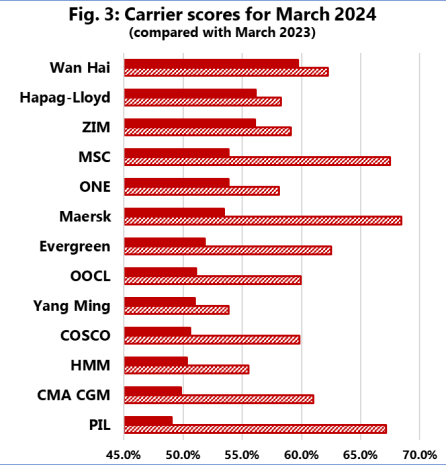Schedule Reliability Shows Gradual Improvement Amid Red Sea Crisis
Amidst the challenges posed by the Red Sea crisis, there are encouraging signs of progress in global schedule reliability, as highlighted by Sea-Intelligence’s latest findings. The March 2024 statistics reveal a notable uptick of 1.6 percentage points month-over-month (MoM), reaching 54.6 percent.
Issue 152 of the Global Liner Performance (GLP) report by the maritime data company presents comprehensive data on schedule reliability, encompassing 34 trade routes and over 60 carriers. Despite a year-over-year (YoY) decline of -7.9 percentage points, the average delay for late vessel arrivals saw improvement, decreasing by -0.52 days MoM to 5.03 days, compared to pre-crisis levels from November 2023.
Read also: Red Sea Global Trade Disruptions: How to Overcome the Chaos
Among the top 13 carriers, Wan Hai emerged as the most reliable in March 2024, boasting a schedule reliability of 59.7 percent. Hapag-Lloyd and ZIM closely followed, with schedule dependability rates of 56.1 percent each. Notably, 11 out of the top 13 carriers witnessed MoM improvements in schedule reliability, with Wan Hai leading the pack with an impressive increase of 11.1 percentage points.
However, challenges persist, as reflected in the year-over-year comparisons. None of the 13 carriers showed gains in schedule reliability compared to the previous year, with PIL experiencing the most significant decrease of -18.1 percentage points. Despite this, there is a sense of cautious optimism as the industry moves forward.

In February, Sea-Intelligence reported a similar trend, with global schedule reliability witnessing a 1.7 percentage point MoM increase to 53.3 percent. These incremental improvements underscore the resilience of the industry amidst ongoing disruptions, offering hope for continued progress in the face of adversity.





Leave a Reply